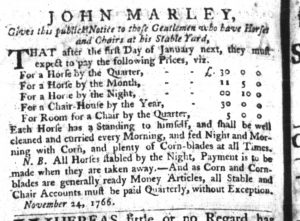What was advertised in a colonial American newspaper 250 years ago today?

“All Stable and Chair Accounts must be paid Quarterly.”
Eighteenth-century wholesalers sometimes advertised discounts for purchasing in volume, but rarely provided particulars rather than promises. In today’s advertisement, John Marley offered discount pricing for a service he provided, caring for horses at his “Stable Yard” in Charleston. Although his notice was addressed to “those Gentlemen who have Horses and Chairs at his Stable Yard” already, it communicated discounts to anyone who happened to read it, including current and prospective customers.
Marley gave customers three options, listing rates “For a Horse by the Quarter,” “For a Horse by the Month,” and “For a Horse by the Night.”(*) A single night cost 10 shillings, while a month cost 11 pounds and 5 shillings (or 225 shillings, which makes the calculations more intuitive to modern readers accustomed to the decimal system for currency). Since an entire month of single nights would have cost 15 pounds (or 300 shillings) when purchased individually, the customer who contracted by the month saved 25%, certainly a significant discount that also benefited Marley because it guaranteed consistent business.
Similarly, stabling a horse by the quarter cost 30 pounds (or 600 shillings) compared to 11 pounds and 5 shillings (or 225 shillings). Paying for each month separately would have amounted to 33 pounds and 15 shillings (or 675 shillings). The discount for stabling by the quarter rather than by the month was a more modest 11%, but a savings nonetheless. It was certainly a deal compared to paying by the night for an entire quarter. That would have amounted to a total of 45 pounds (or 900 shillings). In other words, “those Gentlemen who ha[d] Horses” stabled by John Marley saved 33% when they contracted for an entire quarter rather than by the night. Once again, customers benefited from the discounts while the hostler increased the likelihood of having horses in his stable over long periods.
These prices may seem deceptive to modern readers with less experience converting pounds, shillings, and pence, but eighteenth-century readers would have recognized the discounts much more readily. Marley did not need to state explicitly that he offered discounts for stabling horses over an extended period. Instead, he allowed the prices to speak for themselves.
(*) Keep in mind that there were 20 shillings in a pound. As was common in eighteenth-century bookkeeping, the list of prices or rates in this advertisement includes three columns: pounds, shillings, and pence. Marley used “round numbers” that did not include any pence, which streamlined the calculations. (There were 12 pence in a shilling and 240 pence in a pound.)
